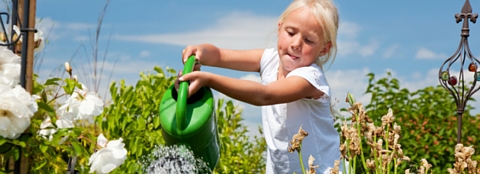June Southern Garden Checklist

Flower Care:
- Avoid drought stress. Water plants thoroughly when the top few inches of soil are crumbly and slightly moist.
- Mulch gardens with a 1-2” layer of evergreen needles, shredded leaves, or other organic material to keep plant roots cool and moist and suppress weeds.
- Give established plants, fertilized 6 to 8 weeks ago, a nutrient boost. Use Milorganite® that won’t burn the plants even during hot dry weather.
- Pay extra attention to perennials planted during hot summer months. Mulch the soil and be prepared to water often. Or focus your planting efforts in shady areas that are less stressful on the plant.
- Pinch mums and asters back to 6 inches throughout June for more compact growth that will be covered with flowers in fall.
- Fertilize your palms if needed. Use Milorganite, a low nitrogen slow release fertilizer that won’t burn in hot dry weather.
Vegetable Garden Planting and Harvest:
- Continue planting heat tolerant vegetables like collards, cantaloupe, eggplant, okra, southern peas, sweet potatoes and watermelon. Add compost and Milorganite fertilizer to the soil prior to planting.
- Harvest herbs as needed. Regular harvesting encourages tender new growth for future picking.
- Harvest vegetables regularly to keep the plants producing and ensure the best flavor and nutritional value.
- Blossom end rot on tomatoes is caused by fluctuations in soil moisture that leads to calcium deficiencies. Avoid root damage, mulch the soil and water thoroughly as needed. Cut out the black portion and enjoy the rest of the fruit.
- Increase your gardening space and reduce pest problems by growing pole beans, melons, squash and cucumber on a trellis, fence or decorative obelisk.
Pest and Disease Control:
- Control small populations of mites and aphids with a strong blast of water from the garden hose. Larger populations can be controlled with insecticidal soap or horticulture oil. Read and follow all label directions before applications.
- Hand pick Japanese beetles, small, metallic-green insects, and place in container of soapy water. These voracious insects feed on the flowers and leaves of over 300 different types of plants.
- Remove spotted, blotchy or discolored leaves as soon as they are found. Sanitation is the best first step in controlling diseases.

